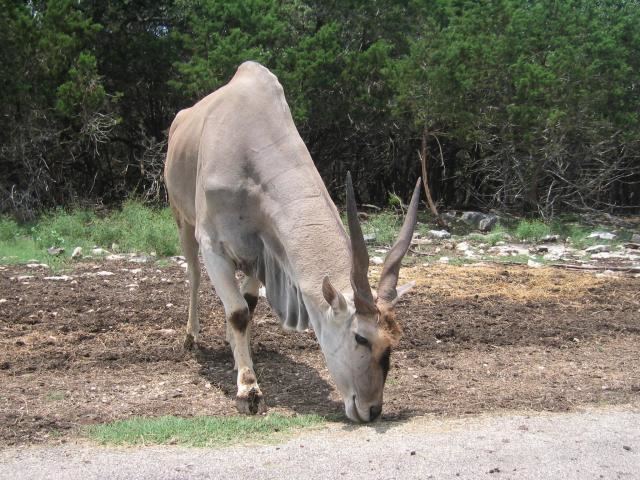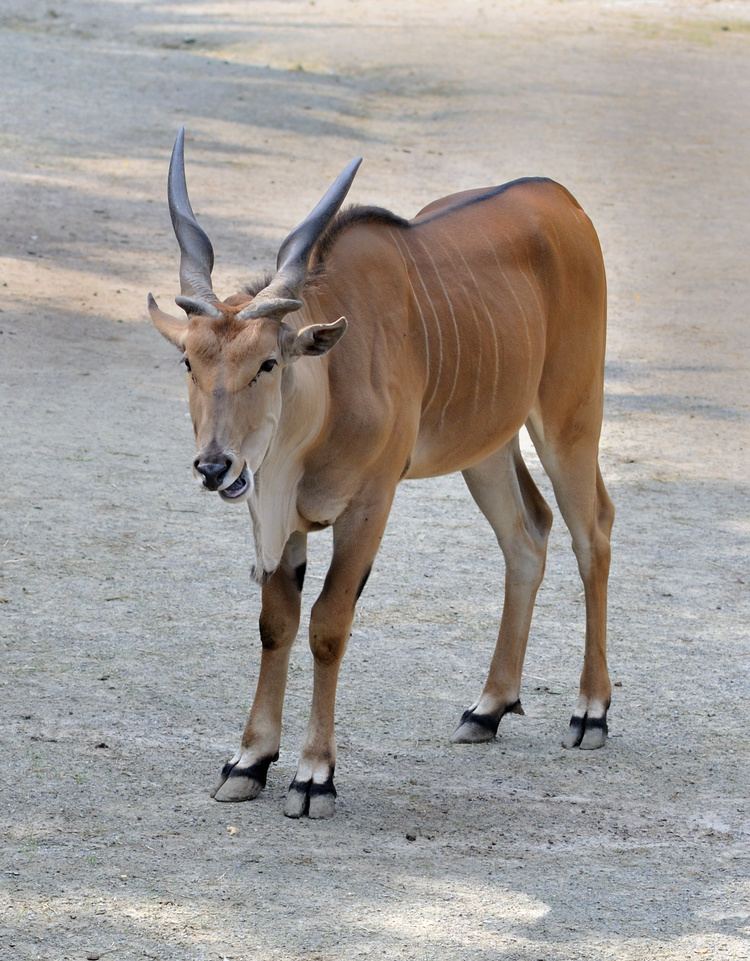Order Artiodactyla Height Common eland: 1.6 m | Phylum Chordata Scientific name Taurotragus Gestation period Common eland: 274 days | |
 | ||
Genus TaurotragusWagner, 1855 Lifespan Common eland: 15 – 20 years Mass Common eland: 400 – 940 kg Lower classifications Common eland, Giant eland | ||
Livingstone s eland taurotragus oryx livingstonii
Taurotragus is a genus of large antelopes of the African savanna, commonly known as elands. It contains two species: the common eland T. oryx and the giant eland T. derbianus.
Contents
- Livingstone s eland taurotragus oryx livingstonii
- Eland taurotragus oryx
- Taxonomy
- Genetics and evolution
- Differences between species
- References

Eland taurotragus oryx
Taxonomy
Taurotragus is a genus of large African antelopes, placed under the subfamily Bovinae and family Bovidae. The genus authority is the German zoologist Johann Andreas Wagner, who first mentioned it in the journal Die Säugthiere in Abbildungen nach der Natur, mit Beschreibungen in 1855. The name is composed of two Greek words: Taurus or Tauros, meaning a bull or bullock; and Tragos, meaning a male goat, in reference to the tuft of hair that grows in the eland's ear which resembles a goat's beard.
The genus consists of two species:


Taurotragus is sometimes considered part of the genus Tragelaphus on the basis of molecular phylogenetics. Together with the bongo, giant eland and common eland are the only antelopes in the tribe Tragelaphini (consisting of Taurotragus and Tragelaphus) to be given a generic name other than Tragelaphus. Although some authors, like Theodor Haltenorth, regarded the giant eland as conspecific with the common eland, they are generally considered two distinct species.
Genetics and evolution
The eland have 31 male chromosomes and 32 female chromosomes. In a 2008 phylogenomic study of spiral-horned antelopes, chromosomal similarities were observed between cattle (Bos taurus) and eight species of spiral-horned antelopes, namely: nyala (Tragelaphus angasii), lesser kudu (T. imberbis), bongo (T. eurycerus), bushbuck (T. scriptus), greater kudu (T. strepsiceros), sitatunga (T. spekei), giant eland and common eland. It was found that chromosomes involved in centric fusions in these species used a complete set of cattle painting probes generated by laser microdissection. The study confirmed the presence of the chromosome translocation known as Robertsonian translocation (1;29), a widespread evolutionary marker common to all known tragelaphid species.
An accidental mating between a male giant eland and a female kudu produced a male offspring, but it was azoospermic. Analysis showed that it completely lacked germ cells, which produce gametes. Still, the hybrid had a strong male scent and exhibited male behaviour. Chromosomal examination showed that chromosomes 1, 3, 5, 9, and 11 differed from the parental karyotypes. Notable mixed inherited traits were pointed ears as the eland's, but a bit widened like kudu's. The tail was half the length of that of an eland, with a terminal tuft of hair as in kudu. Female elands can also act as surrogates for bongos.
The bovid ancestors of the eland evolved approximately 20 million years ago in Africa; fossils are found throughout Africa and France but the best record appears in sub-Saharan Africa. The first members of the tribe Tragelaphini appear 6 million years in the past during the late Miocene. An extinct ancestor of the common eland (Taurotragus arkelli) appears in the Pleistocene in northern Tanzania and the first T. oryx fossil appears in the Holocene in Algeria. Previous genetic studies of African savanna ungulates revealed the presence of a long-standing Pleistocene refugium in eastern and southern Africa, which also includes the giant eland. The common eland and giant eland have been estimated to have diverged about 1.6 million years ago.
Differences between species
Both the species of eland are large spiral-horned antelopes. Though the giant eland broadly overlaps in size with the common eland, the former is somewhat larger on average than the latter. In fact, the giant eland is the largest species of antelope in the world. Eland are sexually dimorphic, as the females are smaller than males. The two eland species are nearly similar in height, ranging from 130–180 cm (51–71 in). In both species, males typically weigh 400 to 1,000 kg (880 to 2,200 lb) while females weigh 300 to 600 kg (660 to 1,320 lb).
The coat of the common eland is tan for females, and darker with a bluish tinge for males. The giant eland is reddish-brown to chestnut. The coat of the common eland varies geographically; the eland in southern Africa lack the distinctive markings (torso stripes, markings on legs, dark garters and a spinal crest) present in those from the northern half of the continent. Similarly, the giant eland displays 8 to 12 well-defined vertical white torso stripes. In both species the coat of the males darken with age. According to zoologist Jakob Bro-Jørgensen, the colour of the male's coat can reflect the levels of androgen, a male hormone, which is highest during rutting.
